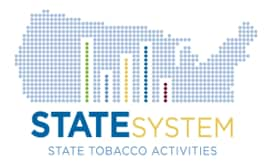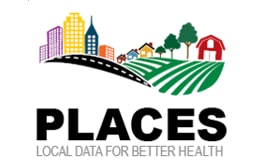Indicator Definitions – Tobacco

Tobacco use is the leading cause of preventable disease, disability, and death in the United States. Based on 2019 data, 1 in 5 adults and more than 1 in 3 high school students used a tobacco product. Over 16 million people live with at least one disease caused by smoking, and 58 million nonsmoking Americans are exposed to secondhand smoke.
Increasing the use of evidence-based commercial tobacco control interventions (e.g., raising the price of tobacco products, smoke-free policies in public places, hard hitting media campaigns, and increasing equitable cessation access) can reduce tobacco use prevalence and related disease. CDC’s Office on Smoking and Health provides funding to help support all 50 states, the District of Columbia, 8 U.S. territories, and 26 tribes/tribal organizations for tobacco control efforts.
For more information visit CDC’s Office on Smoking and Health
Definition Details
| Population: | Students in grades 9–12 |
| Numerator: | Students in grades 9–12 who report having used at least one of the following: 1) cigarettes; 2) cigars, cigarillos, or little cigars; 3) smokeless tobacco; 4) electronic vapor products during the previous 30 days. |
| Denominator: | Students in grades 9–12 who reported information about cigarette, cigar, smokeless tobacco, and electronic vapor product use. |
| Measure: | Prevalence (crude) |
| Time Period of Case Definition: | Past 30 days |
| Summary: | Tobacco product use is started and established primarily during adolescence.1,2 The use of tobacco products containing nicotine in any form among youth is unsafe, and can harm the developing adolescent brain.3 In 2019, current use of any tobacco product among high school students was 36.5%.4 Tobacco product use is started and established primarly during adolescence.1,2 Flavorings in tobacco products can make them more appealing to youth.5 The effects of nicotine exposure during adolescence can include developing nicotine addiction and addition to tobacco products, mood disorders, lower impulse control, and priming the brain for addiction to other drugs.3
National, state, and local program activities have reduced and prevented youth tobacco use when implemented together.2 Some of these activities include higher costs for tobacco products, prohibiting smoking and electronic vapor product use in indoor areas, and community programs and school policies that encourage tobacco-free places and lifestyles.2,3,6 |
| Notes: | None |
| Data Source: | Youth Risk Behavior Surveillance System (YRBSS) |
| Related Objectives or Recommendations: | Healthy People 2030 objective: TU-04. Reduce current tobacco use in adolescents |
| Related CDI Topic Area: | Student Health |
| Reference 1: | National Center for Chronic Disease Prevention and Health Promotion, Office on Smoking and Health. The Health Consequences of Smoking—50 Years of Progress: A Report of the Surgeon General. Centers for Disease Control and Prevention, US Dept of Health and Human Services; 2014. https://www.ncbi.nlm.nih.gov/books/NBK179276/pdf/Bookshelf_NBK179276.pdf |
| Reference 2: | Office of the Surgeon General. 2012 Surgeon General’s Report: Preventing Tobacco Use Among Youth and Young Adults. US Dept of Health and Human Services; 2012. Accessed April 5, 2023. https://www.ncbi.nlm.nih.gov/books/NBK99237/pdf/Bookshelf_NBK99237.pdf |
| Reference 3: | Office of the Surgeon General. E-cigarette use among youth and young adults: a report of the Surgeon General. US Department of Health and Human Services; 2016. https://www.cdc.gov/tobacco/data_statistics/sgr/e-cigarettes/pdfs/2016_sgr_entire_report_508.pdf |
| Reference 4: | Creamer MR, Jones SE, Gentzke AS, Jamal A, King BA. Youth risk behavior surveillance — United States, 2019. MMWR Morb Mortal Wkly Rep. 2020;69(1):56–63. https://www.cdc.gov/healthyyouth/data/yrbs/pdf/2019/su6901-H.pdf |
| Reference 5: | Corey CG, Ambrose BK, Apelberg BJ, King BA. Flavored tobacco product use among middle and high school students–United States, 2014. MMWR Morb Mortal Wkly Rep. 2015;64(38):1066–1070. doi:10.15585/mmwr.mm6438a2 |
| Reference 6: | Centers for Disease Control and Prevention. Best Practices for Comprehensive Tobacco Control Programs—2014. Centers for Disease Control and Prevention, 2014. https://www.cdc.gov/tobacco/stateandcommunity/guides/pdfs/2014/comprehensive.pdf |
| Population: | Students in grades 9–12 |
| Numerator: | Students in grades 9–12 who report having used electronic vapor products on 1 or more of the previous 30 days |
| Denominator: | Students in grades 9–12 who reported information about electronic vapor product use in the previous 30 days. |
| Measure: | Prevalence (crude) |
| Time Period of Case Definition: | Past 30 days |
| Summary: | The use of tobacco products containing nicotine in any form among youth is unsafe and can harm the developing adolescent brain.1 Since their introduction in the US marketplace in 2007, electronic vapor product use is now prolific among adolescents, with 32.7% of high school students currently using these products in 2019, more than 5 times higher than current cigarette smoking.2 Most e-cigarettes contain nicotine which is highly addictive and can harm adolescent brain development.3 Additionally, besides nicotine, e-cigarette aerosol can contain other harmful and potentially harmful substances including heavy metals, volatile organic compounds and other cancer causing agents.1 The effects of nicotine exposure during adolescence can include developing nicotine addiction, mood disorders, lower impulse control, and priming the brain for addiction to other drugs.1 Adolescents who use e-cigarettes may be more likely to smoke cigarettes in the future.4,5 Adolescents may be particularly vulnerable to the risks of e-cigarettes as they are targeted at new consumers with advertisements and flavors. |
| Notes: | None |
| Data Source: | Youth Risk Behavior Surveillance System (YRBSS) |
| Related Objectives or Recommendations: | Healthy People 2030 objective: TU-05. Reduce current use of e-cigarettes among adolescents |
| Related CDI Topic Area: | Student Health |
| Reference 1: | Office of the Surgeon General. 2016 Surgeon General’s Report: E-Cigarette Use Among Youth and Young Adults. US Dept of Health and Human Services; 2016. https://www.cdc.gov/tobacco/sgr/e-cigarettes/pdfs/2016_sgr_entire_report_508.pdf |
| Reference 2: | Creamer MR, Jones SE, Gentzke AS, Jamal A, King BA. Youth risk behavior surveillance — United States, 2019. MMWR Morb Mortal Wkly Rep. 2020;69(1):56–63. https://www.cdc.gov/healthyyouth/data/yrbs/pdf/2019/su6901-H.pdf |
| Reference 3: | Marynak KL, Gammon DG, Rogers T, Coats EM, Singh T, King BA. Sales of nicotine-containing electronic cigarette products: United States, 2015. Am J Public Health. 2017;107(5):702–705. doi:10.2105/AJPH.2017.303660 |
| Reference 4: | Miech R, Patrick ME, O’Malley PM, Johnston LD. E-cigarette use as a predictor of cigarette smoking: results from a 1-year follow-up of a national sample of 12th grade students. Tob Control. 2017;26(e2):e106–e111. doi:10.1136/tobaccocontrol-2016-053291 |
| Reference 5: | Bold KW, Kong G, Camenga DR, et al. Trajectories of e-cigarette and conventional cigarette use among youth. Pediatrics. 2018;141(1):e20171832. doi:10.1542/peds.2017-1832 |
| Population: | Students in grades 9–12 |
| Numerator: | Students in grades 9–12 who report having used smokeless tobacco on 1 or more of the previous 30 days |
| Denominator: | Students in grades 9–12 who reported information about smokeless tobacco use in the previous 30 days. |
| Measure: | Prevalence (crude) |
| Time Period of Case Definition: | Previous 30 days |
| Summary: | Tobacco product use is started and established primarily during adolescence.1,2 Smokeless tobacco is associated with many health problems, and in 2019, 3.8% of high school students reported currently using this product. 3 Using smokeless tobacco may: increase the risk for death from heart disease and stroke;34,5 can cause nicotine poisoning in youth;6 can lead to nicotine addiction;1,4 and is associated with disease of the mouth.2 Because young people who use smokeless tobacco can become addicted to nicotine, they may be more likely to also become cigarette smokers.7 |
| Notes: | None |
| Data Source: | Youth Risk Behavior Surveillance System (YRBSS) |
| Related Objectives or Recommendations: | Healthy People 2030 objective: TU-08. Reduce current use of smokeless tobacco products among adolescents |
| Related CDI Topic Area: | Student Health |
| Reference 1: | Office of the Surgeon General. The Health Consequences of Smoking—50 Years of Progress: A Report of the Surgeon General. US Dept of Health and Human Services; 2014. https://www.ncbi.nlm.nih.gov/books/NBK179276/pdf/Bookshelf_NBK179276.pdf |
| Reference 2: | Office of the Surgeon General. 2012 Surgeon General’s Report: Preventing Tobacco Use Among Youth and Young Adults. US Dept of Health and Human Services; 2012. https://www.cdc.gov/tobacco/data_statistics/sgr/2012/index.htm |
| Reference 3: | Creamer MR, Jones SE, Gentzke AS, Jamal A, King BA. Youth risk behavior surveillance — United States, 2019. MMWR Morb Mortal Wkly Rep. 2020;69(1):56–63. https://www.cdc.gov/healthyyouth/data/yrbs/pdf/2019/su6901-H.pdf |
| Reference 4: | Smokeless Tobacco and Some Tobacco-specific N-Nitrosamines: IARC Monographs on the Evaluation of Carcinogenic Risks to Humans Volume 89. World Health Organization, International Agency for Research on Cancer; 2007. |
| Reference 5: | Piano MR, Benowitz NL, Fitzgerald GA, et al. Impact of smokeless tobacco products on cardiovascular disease: implications for policy, prevention, and treatment: a policy statement from the American Heart Association. Circulation. 2010;122(15):1520–1544. doi:10.1161/CIR.0b013e3181f432c3 |
| Reference 6: | Connolly GN, Richter P, Aleguas A Jr, Pechacek TF, Stanfill SB, Alpert HR. Unintentional child poisonings through ingestion of conventional and novel tobacco products. Pediatrics. 2010;125(5):896–899. doi:10.1542/peds.2009-2835 |
| Reference 7: | Lund I, Scheffels J. Smoking and Snus Use Onset: Exploring the Influence of Snus Debut Age on the Risk for Smoking Uptake With Cross-Sectional Survey Data. Nicotine Tob Res. 2014;16(6):815–9 . |
| Population: | All adults |
| Numerator: | Adults who report having smoked ≥ 100 cigarettes in their lifetime and currently smoke every day or some days |
| Denominator: | Adults aged ≥ 18 years who reported information about cigarette smoking. |
| Measure: | Prevalence (crude and age-adjusted) |
| Time Period of Case Definition: | Current |
| Summary: | More than 480,000 deaths each year are attributed to cigarette smoking and exposure to tobacco smoke, making it the leading preventable cause of death in the United States.1 In 2020, 12.5% of adults currently smoked cigarettes.2 Smoking increases the risk of heart disease, stroke, multiple types of cancer, and chronic lung disease.3 Quitting smoking is beneficial to health at any age, reduces the risk of premature death, and can add as much a 10 years to life expectancy.3, 4 |
| Notes: | Indicator does not convey the lifetime or current number of cigarettes smoked. Each of these factors can affect the risk for acquiring chronic disease from smoking cigarettes. Additionally, the indicator does not measure intent or attempts to quit smoking among smokers or exposure to secondhand smoke among nonsmokers. |
| Data Source: | Behavioral Risk Factor Surveillance System (BRFSS) |
| Related Objectives or Recommendations: | Healthy People 2030 objective: TU-02. Reduce current cigarette smoking in adults |
| Related CDI Topic Area: | Tobacco |
| Reference 1: | National Center for Chronic Disease Prevention and Health Promotion, Office on Smoking and Health. The Health Consequences of Smoking—50 Years of Progress: A Report of the Surgeon General. Centers for Disease Control and Prevention, US Dept of Health and Human Services; 2014. https://www.ncbi.nlm.nih.gov/books/NBK179276/pdf/Bookshelf_NBK179276.pdf |
| Reference 2: | Cornelius ME, Loretan CG, Wang TW, Jamal A, Homa DM. Tobacco product use among adults – United States, 2020. MMWR Morb Mortal Wkly Rep. 2022;71(11):397–405. doi:10.15585/mmwr.mm7111a1 |
| Reference 3: | Office of the Surgeon General. 2010 Surgeon General’s Report: How Tobacco Smoke Causes Disease: The Biology and Behavioral Basis for Smoking-Attributable Disease. US Dept of Health and Human Services; 2010. https://www.ncbi.nlm.nih.gov/books/NBK53017/pdf/Bookshelf_NBK53017.pdf |
| Reference 4: | Office of the Surgeon General. Smoking Cessation: A Report of the Surgeon General. US Dept of Health and Human Services; 2020. https://www.hhs.gov/sites/default/files/2020-cessation-sgr-full-report.pdf |
| Population: | Women who have had a recent live birth |
| Numerator: | Number of women who smoked cigarettes in the last 3 months of their pregnancy. All response options other than ‘I didn’t smoke then’ to a question about number of cigarettes smoked on an average day indicate having smoked. |
| Denominator: | Number of women who did or did not smoke cigarettes in the last 3 months of their pregnancy. |
| Measure: | Prevalence (crude) |
| Time Period of Case Definition: | During the last three months of the pregnancy resulting in the most recent live birth |
| Summary: | Women who smoke cigarettes during pregnancy are at increased risk of pregnancy complications, including ectopic pregnancy and miscarriage, as well as poor infant outcomes, including restricted fetal growth, cleft lip and/or cleft palate, preterm delivery, and sudden infant death syndrome.1 Pregnant smokers should be offered effective smoking cessation interventions or referred to cessation services.2 In addition to reducing adverse pregnancy outcomes, women who quit smoking during pregnancy may continue to abstain from smoking postpartum, a long-term health benefit for the mother and child.1 |
| Notes: | Pregnant women might underreport smoking and overreport quitting smoking. A validation study comparing self-reports with serum cotinine found that 23% of pregnant smokers did not disclose their smoking.3 |
| Data Source: | Pregnancy Risk Assessment Monitoring System (PRAMS) |
| Related Objectives or Recommendations: | Healthy People 2030 objective: MICH-10. Increase abstinence from cigarette smoking among pregnant women |
| Related CDI Topic Area: | Maternal Health |
| Reference 1: | Office of the Surgeon General. The Health Consequences of Smoking—50 Years of Progress: A Report of the Surgeon General. US Dept of Health and Human Services; 2014. https://www.ncbi.nlm.nih.gov/books/NBK179276/pdf/Bookshelf_NBK179276.pdf |
| Reference 2: | American College of Obstetricians and Gynecologists’ Committee on Obstetric Practice in collaboration with committee member Amy M. Valent and the American Academy of Family Physicians’ liaison member Beth Choby. Tobacco and nicotine cessation during pregnancy: ACOG committee opinion, number 807. Obstet Gynecol. 2020;135(5):e221–e229. doi:10.1097/AOG.0000000000003822 |
| Reference 3: | Dietz PM, Homa D, England LJ, et al. Estimates of nondisclosure of cigarette smoking among pregnant and nonpregnant women of reproductive age in the United States. Am J Epidemiol. 2011;173(3):355–359. doi:10.1093/aje/kwq381 |
| Population: | Adults who currently smoke cigarettes |
| Numerator: | Adults who currently smoke cigarettes or formerly smoked but are abstinent less than 365 days who quit smoking for 1 day or longer during the 12 months prior to the interview. |
| Denominator: | Adults who currently smoke cigarettes or formerly smoked but are abstinent less than 365 days. |
| Measure: | Prevalence (crude and age-adjusted) |
| Time Period of Case Definition: | Past 12 months |
| Summary: | More than 480,000 deaths each year are attributed to cigarette smoking and exposure to tobacco smoke, making it the leading preventable cause of death in the United States.1 In 2018, 55.1% of adults who currently smoked cigarettes attempted to quit in the past year.2 Smoking increases the risk of heart disease, stroke, multiple types of cancer, and chronic lung disease.3 Quitting smoking is beneficial to health at any age, reduces the risk of premature death, and can add as much a 10 years to life expenctancy.3,4 |
| Notes: | The indicator does not reflect actual cessation. Tobacco dependence is a chronic condition, with many adults who smoke making repeated quit attempts before they achieve long-term success. |
| Data Source: | Behavioral Risk Factor Surveillance System (BRFSS) |
| Related Objectives or Recommendations: | Healthy People 2030 objective: TU-11. Increase past-year attempts to quit smoking in adults |
| Related CDI Topic Area: | None |
| Reference 1: | National Center for Chronic Disease Prevention and Health Promotion, Office on Smoking and Health. The Health Consequences of Smoking—50 Years of Progress: A Report of the Surgeon General. Centers for Disease Control and Prevention, US Dept of Health and Human Services; 2014. https://www.ncbi.nlm.nih.gov/books/NBK179276/pdf/Bookshelf_NBK179276.pdf |
| Reference 2: | Creamer MR, Wang TW, Babb S, et al. Tobacco product use and cessation indicators among adults — United States, 2018. MMWR Morb Mortal Wkly Rep. 2019;68(45):1013–1019. doi:10.15585/mmwr.mm6845a2 |
| Reference 3: | Office on Smoking and Health, National Center for Chronic Disease Prevention and Health Promotion. 2010 Surgeon General’s Report: How Tobacco Smoke Causes Disease: The Biology and Behavioral Basis for Smoking-Attributable Disease. Centers for Disease Control and Prevention, US Dept of Health and Human Services; 2010. http://www.cdc.gov/tobacco/data_statistics/sgr/2010/index.htm |
| Reference 4: | Office on Smoking and Health, National Center for Chronic Disease Prevention and Health Promotion. Smoking Cessation: A Report of the Surgeon General. Centers for Disease Control and Prevention, US Dept of Health and Human Services; 2020. https://www.cdc.gov/tobacco/sgr/2020-smoking-cessation/index.html |
| Population: | States |
| Numerator: | State population covered by a state or local comprehensive smoke-free policy prohibiting smoking in all indoor areas of workplaces and public places, including restaurants and bars. |
| Denominator: | Population in each state |
| Measure: | Percentage of population covered by a state or local comprehensive smoke-free policy in each state |
| Time Period of Case Definition: | Newly enacted state legislation in effect as of the last day of the quarter is updated in the STATE system on a quarterly basis; local data from ANR collected quarterly |
| Summary: | Secondhand smoke exposure contributes to approximately 41,000 deaths among nonsmoking adults and 400 deaths in infants each year.1 In 2006, the Surgeon General reported that there is no level of risk-free exposure to secondhand smoke.2 The only effective way to eliminate involuntary exposure to secondhand smoke is to eliminate smoking completely in all indoor areas.2 Comprehensive smoke-free laws are those that prohibhit smoking in all indoor areas of private workplaces and public places, including restaurants and bars.
Considerable progress has been made at state and local levels in the adoption of comprehensive smoke-free laws in indoor public places over the past two decades.3 However, continued efforts to promote implementation of statewide and local comprehensive smoke-free laws are critical to protect nonsmokers from this preventable health hazard in the places they live, work, and gather.3 |
| Notes: | Some states and jurisdictions may have smoke-free policies, but they are not stringent enough to meet the definition for a comprehensive policy established by the CDC |
| Data Source: | American Nonsmokers’ Rights Foundation (ANRF) |
| Related Objectives or Recommendations: | Healthy People objectives: TU‑17. Increase the number of states, territories, and DC that prohibit smoking in worksites, restaurants, and bars; TU-19. Reduce the proportion of people who don’t smoke but are exposed to secondhand smoke |
| Related CDI Topic Area: | None |
| Reference 1: | US Department of Health and Human Services. The health consequences of smoking—50 years of progress. Atlanta, GA: US Department of Health and Human Services, CDC; 2014. http://www.cdc.gov/tobacco/data_statistics/sgr/50th-anniversary/index.htm |
| Reference 2: | Office of the Surgeon General. The Health Consequences of Involuntary Exposure to Tobacco Smoke: A Report of the Surgeon General. US Dept of Health and Human Services; 2006. https://www.ncbi.nlm.nih.gov/books/NBK44324 |
| Reference 3: | Tynan MA, Holmes CB, Promoff G, Hallett C, Hopkins M, Frick B. State and local comprehensive smoke-free laws for worksites, restaurants, and bars — United States, 2015. MMWR Morb Mortal Wkly Rep. 2016;65(24):623–626. doi:10.15585/mmwr.mm6524a4 |
Additional Data Sources

| Fast Facts and Fact Sheets | Smoking and Tobacco Use | CDC |

| State Tobacco Activities Tracking and Evaluation (STATE) System (cdc.gov) |

| PLACES: Local Data for Better Health | CDC |
